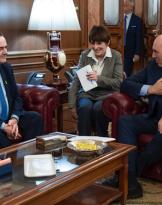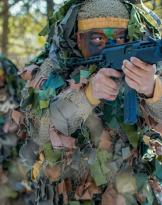The monumental building, the current institutional seat of the Air Force, was commissioned by the then Minister of the Royal Air Force (1926-1933) Italo Balbo who, for the design, turned to an architect of only 28 years, Roberto Marino; the works were completed in two years and the building is considered the first in Italy to be built entirely in reinforced concrete.
The building is designed with wide and safe lines to underline, in the intent of the age, the characteristics of a modern Rome. The interior was conceived with new criteria: large rooms (in place of the old cellular system) in which the officials' tables are aligned; the partitions dividing the halls from the corridors are mostly of transparent glass; the building, vast, covers an area of about 8000 square meters.
Simplicity and elegance can also be found in the decorative elements, not evident but significant, such as the handles that stylize a wing profile or the motif of the "Command staff", then a distinctive sign of the pilot officers, re-proposed as an elegant and completely invasive embellishment of metal railings of the Staircase of Honor, of the glass doors of the Halls of Heroes and of the Clouds, even reported in the imposing covers of the radiators installed in the Halls of Honor.
The Sala Italia, the Sala Europa and the Sala delle Cartine are expertly decorated with murals of a geographical, astronomical and historical nature. The last of the three rooms mentioned, in particular, represents the two Atlantic cruises led by Balbo himself in the 1930 and in the 1933, respectively in Brazil and the United States. The three halls were the three entrances to the small room of Italo Balbo - on whose wall was written "Beyond destiny", as if to accentuate the importance of the visit to the minister, charging them with expectation, for the heads of been invited to the Palazzo.
The functionality of the Palace was also highlighted by lifelong lifts, "lift to paternoster" (it consists of two adjacent and parallel columns of cabins - capable of accommodating two people - superimposed and in slow continuous movement, one uphill, l 'another downhill, with every served plane, two holes - one for driving direction - allow users to climb or "fly" on or off the cabin) and the "pneumatic mail" system, which allows innovative and at a time when e-mails were a far-reaching reality in the future, immediate communication between the various rooms.
The initiative aims to emphasize the sensitivity of the armed force in pursuing the principle of education to the knowledge and protection of the historical, artistic and architectural heritage of the Nation. This commitment is linked to the same genetic code of the Air Force, based on the shared conscience of a common history of values, traditions, sacrifice and activities at the service of the community.
Source: Head Office Support Command - Rome - Lieutenant Benedetto D'Angelis












